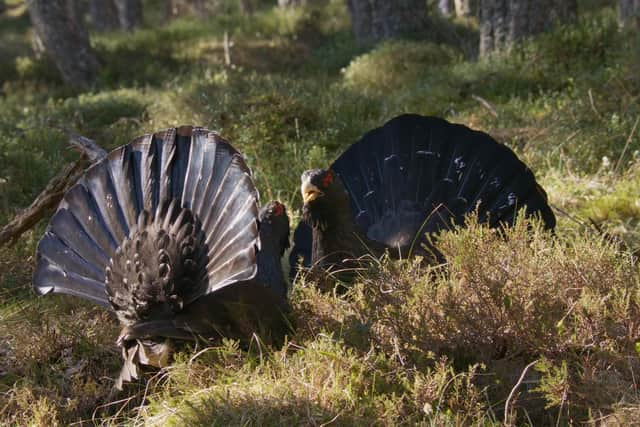Wild Isles: Sir David Attenborough warns the capercaillie is on the brink of going extinct in Scotland for the second time
Filmmakers captured rare footage of the birds forlast night's episode of the BBC nature documentary series Wild Isles, focusing on our woodlands.
Camera operators spent two years at a secret pine forest location near Aviemore to film a lek, when males gather to display and fight for the attention of females.
Advertisement
Hide AdAdvertisement
Hide AdSir David, 96, has warned the spectacular sight and sound of the birds could soon become a thing of the past, however.


The capercaillie was reintroduced to Scotland in 1837 after becoming extinct the previous century. The elusive birds have been in steep decline in recent years and the most recent national survey estimated there are just 542 left.
Around 80 per cent live and breed in pinewoods in the Cairngorms National Park, where the new footage showed feathers flying as one preening alpha male fights off a challenger.
Sir David said: "His reward is to mate with all the females who will then pass on his genes to the next generation. The species as a whole, however, is losing its battle to survive in the Scottish Highlands.
"Capercaillie became extinct in Britain once before, back in the 18th century, and now a combination of disturbance, predation and poor quality habitat is pushing these birds to the brink once more. Soon these extraordinary sights and sounds may disappear from our woodlands for a second time."
Filmmakers went to extraordinary lengths to capture the rare footage of the birds, whose Gaelic name means "Horse of the Woods", it can be revealed.
The sequence was achieved by setting up camouflaged cameras on a traditional capercaillie lek site, operated remotely from a hide 200 metres away.
The team, working under licence from NatureScot, managed to capture the dramatic moment when two males fought for the right to mate with the group of smaller females.
Advertisement
Hide AdAdvertisement
Hide AdChris Howard, producer of last night's episode, said: "When we started filming the series there were estimated to be over 1000 capercaillie, and that has now halved to just over 500, which is sobering in itself.
"Most people don't even know we have these amazing birds in our woodlands so, for me, it was essential to get them in and to make it the best capercaillie sequence that has ever been filmed.
"It took us two years but the result was worth it. Thanks to the remote cameras and the fact we put so much effort into being as far away as possible for minimum disturbance, the birds just acted naturally.
"We knew roughly where the alpha was going to be, and there he was displaying and doing very well. At one point we counted nine females around him and other males off in the distance.
"Finally, one of them plucks up the courage and comes over and decides, with that many females to fight for, it's time to give it a go.
"They face up and posture each other. Like most animals, they want to avoid a fight because it's dangerous. They will size each other up and if there's an obvious mismatch the weaker one will just slink off, but these two males were evenly sized.
"Suddenly, they start swinging these huge wings -- they have a metre wingspan -- and bashing each other, trying to rip feathers out.”
There may be few opportunities to capture such behaviour in the future. The birds are included on the Red List of species of highest conservation concern, with the remaining individuals heavily protected from disturbance.
Mr Howard added: "We are so close to losing them again. It feels like this is the last chance saloon."